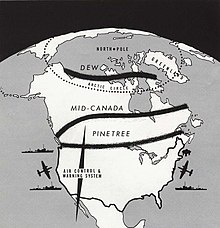| Distant Early Warning Line | |
|---|---|
 | |
| Active | 1957–1993 |
| Country | Canada & United States |
| Branch | Royal Canadian Air Force United States Air Force |
| Type | Early-warning radar |
| Role | Continental air defence |
| Part of | North American Aerospace Defense Command |

The Distant Early Warning Line, also known as the DEW Line or Early Warning Line, was a system of radar stations in the northern Arctic region of Canada, with additional stations along the north coast and Aleutian Islands of Alaska (see Project Stretchout and Project Bluegrass), in addition to the Faroe Islands, Greenland, and Iceland. It was set up to detect incoming bombers of the Soviet Union during the Cold War, and provide early warning of any sea-and-land invasion.
The DEW Line was the northernmost and most capable of three radar lines in Canada and Alaska. The first of these was the joint Canadian-United States Pinetree Line, which ran from Newfoundland to Vancouver Island just north of the Canada–United States border, but even while it was being built there were concerns that it would not provide enough warning time to launch an effective counterattack. The Mid-Canada Line (MCL) was proposed as an inexpensive solution using bistatic radar. This provided a "trip wire" warning located roughly at the 55th parallel, giving commanders ample warning time, but little information on the targets or their exact location. The MCL proved largely useless in practice, as the radar return of flocks of birds overwhelmed signals from aircraft.
The DEW Line was proposed as a solution to both of these problems, using conventional radar systems that could both detect and characterise an attack, while being located far to the north where they would offer hours of advance warning. This would not only provide ample time for the defences to prepare, but also allow the Strategic Air Command to get its active aircraft airborne long before Soviet bombers could reach their targets. The need was considered critical and the construction was given the highest national priorities. Advance site preparation began in December 1954, and the construction was carried out in a massive logistical operation that took place mostly during the summer months when the sites could be reached by ships. The 63-base line reached operational status in 1957. The MCL was shut down in the early 1960s, and much of the Pinetree Line was given over to civilian use.
In 1985, as part of the "Shamrock Summit", the United States and Canada agreed to transition DEW to the new North Warning System (NWS). Beginning in 1988, most of the original DEW stations were deactivated, while a small number were upgraded with all-new equipment.[1] The official handover from DEW to NWS took place on 15 July 1993.
- ^ Lajeunesse, Adam (20 June 2007). "The Distant Early Warning Line and the Canadian Battle for Public Perception". Canadian Military Journal. Archived from the original on 10 February 2024.